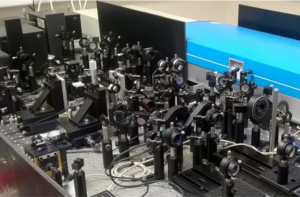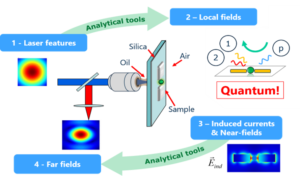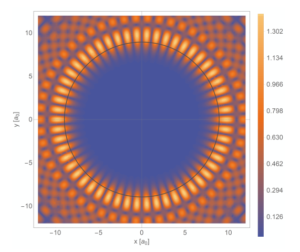Équipe de recherche
Nano-Optics and Forces
Merging (quantum) optics and forces at the nanoscale for opening new horizons in fundamental science
Quantum plasmonics
Toward entangled photon pair generation @ nanoscale
One of the major challenges faced in the development of quantum computers and quantum communication is the integration of devices for generating single photons and photon pairs. In this context, a drastic reduction of the size of devices entails a significant drop in their efficiency of photon generation. One way to overcome this challenging obstacle is to excite local electric field by coupling the emitter to plasmonic nano-antennas.

Recently we have achieved this objective by coupling an emitter which is a non-linear nanocrystal to nano-antennas by placing it within the gap of two antennas. Hence, creating a hybrid nano-structure in order to generate an enhancement by a factor that is 1000 times higher than an isolated nanocrystal. Therefore, the objective of the project is to use experimental as well as theoretical or numerical tools to further optimize second order non-linear processes such as second harmonic generation (SHG) and spontaneous parametric down conversion (SPDC) to enhance their efficiency to several orders of magnitude higher than what is already demonstrated. If successful, this would enable the first ever detection of photon pairs with the so called hybrid plasmonic nanostructure using the experimental setup that we have built.

The groundwork towards achieving this goal has already been completed with the pioneering work conducted during the course of three thesis defended in 2018 and 2019. With the development of a quantitative and numerical tool, the optimal configuration to obtain a strong coupling between the non-linear crystal and plasmonic antenna can be determined. This step therefore involves adapting the developed numerical programmes to new plasmonic antenna configurations, in particular, bowtie and to also search for the best materials (Al, Au, Ag) to obtain plasmonic resonances as well as for nonlinear nanocrystals (in particular for nano-iodates developed by Géraldine Dantelle and organic crystals synthesized by Alain Ibanez at the Néel Institute or for other compounds developed by already established collaborations). In the next step, the hybrid structures will be fabricated at the NanoFab platform of the institute using a technique that was recently realized which allows to place the nano-antennas with precision around the desired non-linear crystal as per its efficiency. In the final step, the hybrid nano-structures will be characterized for SHG emission (using an experimental setup and a technique that has already been realized with extremely reliable results) as well as for SPDC if sufficient enhancement is obtained which will allow us to demonstrate for the first time the generation and detection of photon pairs in hybrid plasmonic nano-structures. While the last aspect is ambitious, its theoretical study would already constitute a significant advance towards applications in quantum engineering.

Contact: guillaume.bachelier@neel.cnrs.fr

